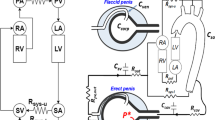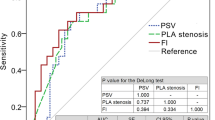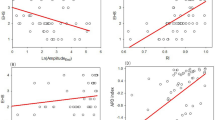Abstract
The purpose was to assess objectively and quantitatively the hemodynamic status and the degree of functional erectile impairment in a group of impotent patients. A clinical study was designed, incorporating pharmacocavernosometry (to evaluate arterial and veno-occlusive function) with axial buckling forces and penile geometry measurements in a group of impotent patients. The pressure gradient between the intracavernosal pressure associated with the presence of penile axial rigidity and the equilibrium intracavernosal pressure was calculated (axial rigidity gradient, ARG); such methodology allowed a quantitative characterization of functional impairment, as ARG expresses the intracavernosal pressure increase necessary to achieve axial rigidity and therefore potency. Penile geometry characteristics were also expressed by calculating the penile aspect ratio (diameter/length, D/L). In 83 consecutive patients tested (mean age 42.89±9.96), rigidity occurred at intracavernosal pressures between 50 and 100 mm Hg. A conversely proportional relation was noticed between penile aspect ratio values and the intracavernosal pressure associated with rigidity values, clearly demonstrating the important functional role of penile geometry. ARG demonstrated a wide range of values (3–69 mm Hg), reflective of the severity of the erectile dysfunction on each patient. Half (50.6%) of the patients had ARG values ≤20 mm Hg, indicative of minimal and minimal-to-moderate erectile impairment, while 20.48% had ARG between 21–30 and 28.92% >30 mm Hg, indicative of moderate and severe erectile dysfunction (ED) respectively. In all, 6% of the study group, all of them with primary ED, ARG <20 mm Hg had normal hemodynamics, but low penile aspect ratio values indicating that penile geometry may be the cause of insufficient rigidity. Hemodynamic integrity is the most critical, but not the only determinant of penile rigidity, as erectile impairment may be noticed in patients with normal arterial inflow and corporal veno-occlusive function. In such cases, unfavorable penile geometry should be considered as the possible etiological factor of impotence.
This is a preview of subscription content, access via your institution
Access options
Subscribe to this journal
Receive 8 print issues and online access
$259.00 per year
only $32.38 per issue
Buy this article
- Purchase on Springer Link
- Instant access to full article PDF
Prices may be subject to local taxes which are calculated during checkout




Similar content being viewed by others
References
Hatzichristou DG, Saenz deTejada I, Kupferman S, Namburi S, Pescatori ES, Udelson D, Goldstein I . In vivo assessment of trabecular smooth muscle tone, its application in pharmacocavernosometry, and analysis of intracavernosal pressure determinants. J Urol, 1995; 153: 1126.
NIH. Consensus development conference statement on impotence. Int J Impot Res, 1993; 5: 181.
Frohrib DA, Goldstein I, Payton TR, Padma-Nathan H, Krane RJ . Characterization of penile erectile states using external computer-based monitoring. J Biomech Eng, 1987; 109: 110.
Udelson D, Nehra A, Hatzichristou DG, Azadzoi K, Moreland RB, Krane RJ, Saenz de Tejada I, Goldstein I . Engineering analysis of penile hemodynamic and structural-dynamic relationships: Part I—clinical implications of penile tissue mechanical properties. Int J Impot Res, 1998; 10: 15.
Udelson D, Nehra A, Hatzichristou DG, Azadzoi K, Moreland RB, Krane RJ, Saenz de Tejada I, Goldstein I . Engineering analysis of penile hemodynamic and structural-dynamic relationships: Part II—clinical implications of penile buckling. Int J Impot Res, 1998; 10: 25.
Udelson D, Nehra A, Hatzichristou DG, Azadzoi K, Moreland RB, Krane RJ, Saenz de Tejada I, Goldstein I . Engineering analysis of penile hemodynamic and structural-dynamic relationships: Part III—clinical implications of penile hemodynamic and rigidity erectile responses. Int J Impot Res, 1998; 10: 89.
Hatzichristou DG, Hatzimouratidis K, Apostolidis A, Ioannidis E, Yannakoyorgos K, Kalinderis A . Hemodynamic characterization of a functional erection: arterial and veno-occlusive function in patients with positive intracavernosal injection test. Eur Urol, 1999; 36: 60.
Lue TF . Erectile dysfunction. N Engl J Med, 2000; 342: 1802.
Pescatori ES, Hatzichristou DG, Namburi S, Goldstein I . A positive intracavernosal injection test implies normal veno-occlusive mechanism but not necessarily normal arterial function: a hemodynamic study. J Urol, 1994; 151: 1209.
Hatzichristou DG . Current treatment and future perspectives for erectile dysfunction. Int J Impot Res 1998; 10: S3.
Feldman HA, Goldstein I, Hatzichristou DG, Krane RJ, McKinlay J . Impotence and its medical and psychosocial correlates: results of the Massachusetts Male Aging Study. J Urol 1994; 151: 54.
Moncada I, Hernandez C, Lledó E, Jara J, Escribano G, Sáenz de Tejada I . Clinical value of measuring flaccid penile diameter/length ratio as a predictor of the intracavernosal pressure required for rigidity. J Urol 1997; 157: 691A.
Author information
Authors and Affiliations
Corresponding author
Rights and permissions
About this article
Cite this article
Hatzichristou, D., Hatzimouratidis, K., Tzortzis, V. et al. Normal hemodynamic parameters do not always predict the presence of a rigid erection: a quantitative assessment of functional erectile impairment. Int J Impot Res 15, 99–104 (2003). https://doi.org/10.1038/sj.ijir.3900953
Received:
Revised:
Accepted:
Published:
Issue Date:
DOI: https://doi.org/10.1038/sj.ijir.3900953



